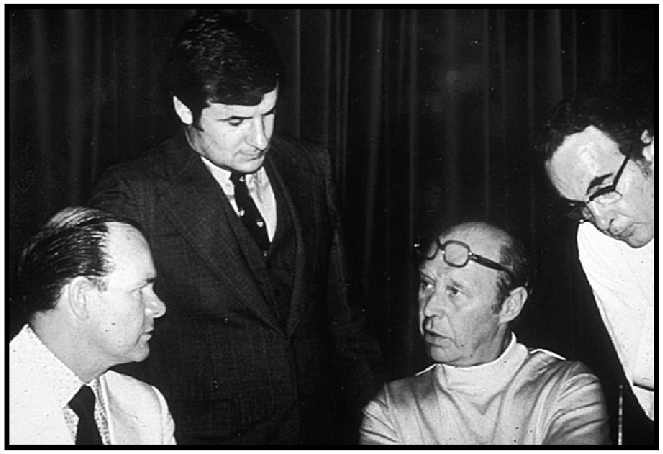The following article is based on an article titled “History of IFOMT” by David W Lamb, Freddy M Kaltenborn and Stanley V Paris. The three authors were pioneering leaders in their field and drivers of the formation of the, now known as, International Federation of Orthopaedic Manipulative Physical Therapists (IFOMPT).
Many other giants in the field also contributed to formation of IFOMPT. Leadership requires strong self belief and ego, so when they collide there is likely to be conflict. The authors themselves politely acknowledge their strong differences of opinion and this is evident throughout the story. To their credit maturity prevailed and the outcome was a strong organisation that has powerfully influenced the profession thereafter.
The authors interchangeably used the terms manual and manipulative therapy. More recently the term musculoskeletal physiotherapy has been used around the world, although an attempt to update IFOMPT’s name failed in 2020.
History of IFOMT
In many respects the birth of manual therapy (as a subset of physiotherapy) occured in England where at St. Thomas’ Hospital there was a long tradition of joint manipulation being instructed to physiotherapists by medical physicians. First was Dr James Mennell, whose son, John, continued the tradition in both New Zealand and the United States. But the giant was Dr James Cyriax who directly influenced Kaltenborn, Grieve and Paris. Lamb, Fowler and many others were to follow.
Although very different in his approach, Medical and osteopathic physician, Dr Alan Stoddard likewise gave freely of his expertise and encouragement. All recognised the need for physiotherapists to upgrade their skills in manual therapy and to be principal players in this field.
In 1954 Kaltenborn in Norway and by 1962 Paris in New Zealand and Maitland in Australia had all become established as leaders in manual therapy. They lectured, gave seminars and courses, and began to publish. The future would establish more leaders, such as Evjenth of Norway, McKenzie of New Zealand, Rocabado of Chile, Grieve of the United Kingdom and Elvey and Twomey of Australia.
In 1967, the Chartered Society of Physiotherapy in England invited Geoffrey Maitland to come and spend a year giving instruction in his methods to English physiotherapists. In the United States Stanley Paris learned of the event and flew to London to meet with Maitland for the first time. Paris also invited Kaltenborn and so in the cafeteria of a London hospital Maitland, Grieve, Kaltenborn and Paris in the company of Monica Martin-Jones and Lois Dwyer discussed the future of manual and manipulative therapy.
Thus was conceived an association to be called the World Confederation of Manual Therapy. Agreements included establishing a newsletter and the need to broaden internationally. In 1970 Paris called a meeting during the World Confederation of Physical Therapists (WCPT) Congress at Amsterdam, where an interim committee was formed. The charge was to meet again four years later in Montreal, Canada to form an international body. It proved to be tumultuous four years.
Paris called upon national groups that were members of WCPT to identify any persons or organisations within their country that could represent manual therapy at the Congress. He envisaged the world confederation as a forum for all who were interested in manual therapy. In contrast Kaltenborn insisted on standards of membership, that would by definition be exclusionary.
Unilaterally Kaltenborn arranged a four week retreat in Gran Canaria in 1973 where 74 experienced manual therapists from 12 countries shared their knowledge and refined their skills. An examination was arranged. Professor Broden set the theoretical paper and a board comprising Drs Cyriax, Brodie, Stoddard and Frisch examined the candidates on specific mobilisation techniques of the spine and peripheral joints. The exams were a prototype and an attempt to create an international examination.
At the conclusion of the examination, the successful candidates formed the International Federation of Manual Therapy. Now there were two groups claiming to represent manual/manipulative therapy. Despite their strong differences, maturity prevailed and the two groups fused at the Montreal meeting in 1974, recognising the need for both a constitutional framework and the need for standards.
Twelve countries were present in Montreal and ten were initially approved as voting members: Australia, Canada, Denmark, Finland, the Netherlands, New Zealand, Norway, South Africa, Sweden, United Kingdom and the United States of America (NB. this is a direct quote of ten countries being initially approved but eleven are listed). Thus the International Federation of Manipulative Therapy was founded. The inaugural meeting included both finalising the constitution and agreeing to formulate and develop educational standards.


It is very interesting (at least for myself) to consider that in 1967 there was no option for electronic interface. News between the UK and Australia might be communicated via phone, but more likely other methods and other a longer time period. I would offer a dedicated intentionality was needed to bring ideas to gather, to convene for meaningful discussion. The scope of influence of regional leaders was potentially quite large and to meld ideas in a uniform fashion was likely a very large lift. To a degree also the influences for the regional development of manual therapy were not just overnight, they developed over quite a long period of time. IFOMPT formed, and will have a 50 yr anniversary next year in Basel, Switzerland, but there was around a 50-150 year backdrop to the manual therapy position of these pioneers (I would offer), and that would of needed to be considered in these conversations. A lot to ponder.
What a fantastic and exciting period that was for the profession and for many of us personally. Rod Farr